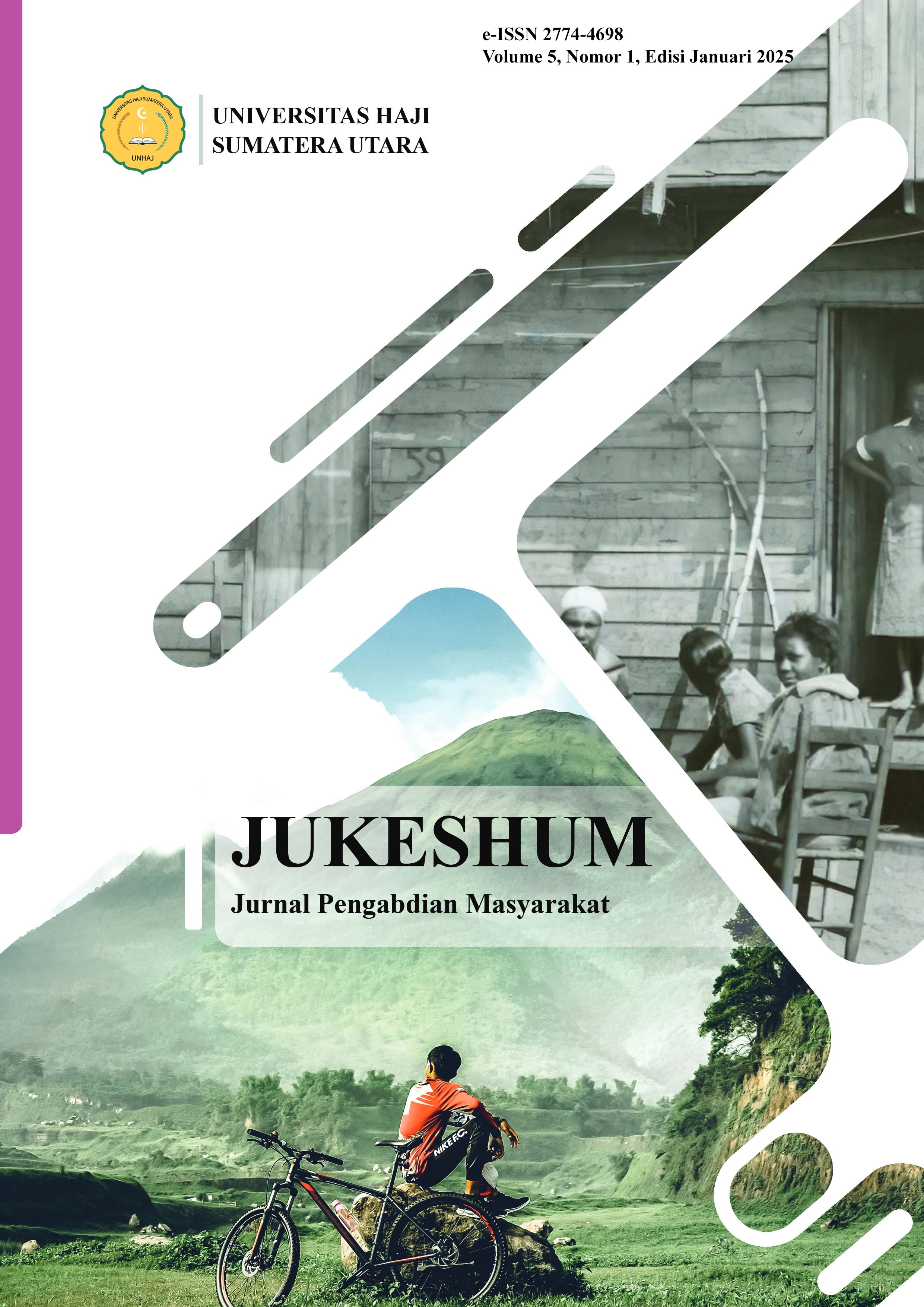m-Health Based GERAT in Prevention and Early Detection of Pulmonary Tuberculosis in the Community of Tanjung Hilir Village Medan
GERAT Berbasis m-Health dalam Pencegahan dan Deteksi Dini Tuberkulosis Paru Pada Masyarakat Kelurahan Tanjung Hilir Medan
DOI:
https://doi.org/10.51771/jukeshum.v5i1.1208Keywords:
Early Detection, Prevention, Pulmonary TuberculosisAbstract
Pulmonary tuberculosis is a bacterial infection caused by Mycobacterium tuberculosis and primarily affects lung tissue. The disease is transmitted through the air when an infected person coughs, sneezes, or talks, releasing germs into the environment. Symptoms of pulmonary TB can include a persistent cough, chest pain, fever, night sweats, and weight loss. If left untreated, pulmonary TB can be serious and potentially life-threatening. This health problem is closely related to the lack of public knowledge regarding early detection of pulmonary TB disease, resulting in a lack of awareness of the importance of early detection. Based on the results of field analysis obtained from the Medan Deli Health Center, where a very serious problem is the low public awareness of the importance of early detection of pulmonary TB and immediately checking the health center if they show signs and symptoms of the disease. This is also in accordance with data submitted by cadres during interviews where ten people were detected as having pulmonary TB and there were several people who had shown signs and symptoms such as coughing for 3 weeks or more and weight loss in the last 3 months, but did not want to go to the health center for examination on the grounds that it was just a normal cough and they were afraid. Objective: The form of activity packaged in this activity is the Anti-Tuberculosis Movement (GERAT) in the prevention and early detection of Pulmonary TB disease which is expected to be a breakthrough in improving health promotion in the community and become a sustainable and scheduled activity in cadre activities.
Method The method used in this service is to use a quantitative method with a sampling technique of simple random sampling by conducting direct interviews and unplanned questions. The number of samples in this service activity is 50 people. The form of education that will be carried out by GERAT is packaged in interesting and interactive activities, using animated video media, booklets and posters and presented in offline and online forms with the mHealth (Mobile Health) application. The offline form carried out is a casual discussion with the community which begins with exploring community knowledge related to the concept of Pulmonary TB, prevention and early detection of Pulmonary TB disease, then continued with the presentation of counseling materials. Results. This community service activity has a sample of 50 people, where the community before the counseling the average knowledge value was 48.32% and after the counseling it became 89.78, which initially many people did not know how to prevent and detect Pulmonary TB early.
Conclusion. With the Community Service activity, it can increase
References
Asfiya, N. A., Prabamurti, P. N., & Kusumawati, A. (2021). No Title. MEDIA KESEHATAN MASYARAKAT INDONESIA; Vol 20, No 6 (2021): MKMIDO - 10.14710/Mkmi.20.6.379-388, 20(6), 379–388. https://ejournal.undip.ac.id/index.php/mkmi/article/view/40507.
Noykhovich, E., Mookherji, S., & Roess, A. (2019). The Risk of Tuberculosis among Populations Living in Slum Settings: a Systematic Review and Meta-analysis. Journal of Urban Health, 96(2), 262–275. https://doi.org/10.1007/s11524-018-0319-6.
Putra, I. W. G. A. E., Kurniasari, N. M. D., Dewi, N. P. E. P., Ketut Suarjana, I., Made Kerta Duana, I., Ketut Hari Mulyawan, I., Riono, P., Alisjahbana, B., Probandari, A., Notobroto, H. B., & Wahyuni, C. U. (2019). The implementation of early detection in tuberculosis contact investigation to improve case finding. Journal of Epidemiology and Global Health, 9(3), 191–197. https://doi.org/10.2991/jegh.k.190808.001.
Putra, O. N., & Hidayatullah, A. Y. N. (2022). Early detection of tuberculosis in patients with smear-negative pulmonary tuberculosis Oki Nugraha Putra, Affan Yuniar Nur Hidayatullah. The Korean Journal of Internal Medicine, 37(5), 1088–1089. https://doi.org/https://doi.org/10.3904/kjim.2021.337.
Quach, S., Michaelchuk, W., Benoit, A., Oliveira, A., Packham, T. L., Goldstein, R., & Brooks, D. (2023). Mobile heath applications for self-management in chronic lung disease: a systematic review. Network Modeling and Analysis in Health Informatics and Bioinformatics, 12(1), 25. https://doi.org/10.1007/s13721-023-00419-0.
Sanusi, T., Widayati, R. I., Riyanto, P., Malik, D. A., & Budiastuti, A. (2021). Tuberculosis cutis colliquativa in an HIV-infected child. International Journal Of Dermatology, 60(12), 514–516. https://doi.org/https://doi.org/10.1111/ijd.15712.
Simmons, J. D., Stein, C. M., Seshadri, C., Campo, M., Campo, M., Fortune, S., Schurr, E., Wallis, R. S., Churchyard, G., Mayanja-Kizza, H., Boom, W. H., & Hawn, T. R. (2018). Immunological mechanisms of human resistance to persistent Mycobacterium tuberculosis infection. Nature Reviews Immunology, 18(9), 575–589. https://experts.umn.edu/en/publications/immunological-mechanisms-of-human-resistance-to-persistent-mycoba.
Williams, P. M., RH, P., WL, W., SF, P., RJ, S., & PI, F. (2024). Tuberculosis — United States, 2023. MMWR Morb Mortal Wkly Rep, 73(12), 265–270. https://doi.org/http://dx.doi.org/10.15585/mmwr.mm7312a4
Downloads
Published
Issue
Section
License
Copyright (c) 2025 Nataria Yanti Silaban, Debora Lestari Simamora, Eka Nugraha V. Naibaho, Devi Devi, Putri Putri

This work is licensed under a Creative Commons Attribution-ShareAlike 4.0 International License.
Hak Cipta dan Lisensi
Penulis yang mempublikasikan naskahnya melalui Jukeshum: Jurnal Pengabdian Masyarakat menyetujui beberapa hal berikut:
- Hak Cipta atas naskah-naskah karya ilmiah di dalam Jurnal ini dipegang oleh Penulis.
- Penulis menyerahkan hak saat pertama kali mempublikasi Naskah karya ilmiahnya dan secara bersamaan Penulis memberikan izin/lisensi dengan mengacu pada Creative Commons Attribution-ShareAlike 4.0 International License kepada pihak lain untuk menyebarkan karya ilmiahnya tersebut dengan tetap mencantumkan penghargaan bagi penulis dan Jukeshum: Jurnal Pengabdian Masyarakat sebagai media Publikasi pertama atas karya tersebut.
- Hal-hal yang berkaitan dengan non-eksklusivitas pendistribusian Jurnal yang menerbitkan karya ilmiah penulis dapat diperjanjikan secara terpisah (contoh: permintaan untuk menempatkan karya yang dimaksud pada perpustakaan suatu institusi atau menerbitkannya sebagai buku) dengan Penulis sebagai salah satu pihak perjanjian dan dengan penghargaan pada Jukeshum: Jurnal Pengabdian Masyarakat sebagai media publikasi pertama atas karya dimaksud.
- Penulis dapat dan diharapkan untuk mengumumkan karyanya secara online (misalnya pada Repositori atau pada laman Organisai/Institusinya) sejak sebelum dan selama proses pengumpulan naskah, sebab upaya tersebut dapat meningkatkan pertukaran citasi lebih awal dan dengan cakupan yang lebih luas.








